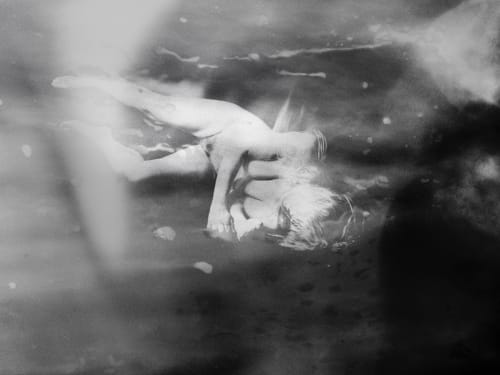When [...] the world of clear and articulate objects is abolished, our perceptual being [...] evolves a spatiality without things. This is what happens in the night. Night is not an object before me; it enwraps me and infiltrates through all my senses [...]. Night has no outlines; [...] it is pure depth without foreground or background, without surfaces and without any distance separating it from me.
Maurice Merleau-Ponty: Phenomenology of Perception
Momentum is pleased to announce that it will exhibit a solo show of the work of Aapo Huhta and his latest series Gravity.
In his new austerely black and white work, Aapo Huhta fills his photographs with a darkness so impenetrable that it dissolves the horizon. This nocturnal void is inhabited by human figures that seem to be shrouded in milky mist or exist behind a veil of cosmic radiation. They are simultaneously both painfully corporeal and infinitely distant, almost like visual echoes from another dimension. These bodies give us no information on the space they inhabit, because their existence does not adhere to the familiar laws of physics.
Three-dimensionality is at peril when Huhta partly dismantles the figurative tradition of the photograph. Through the use of analog processes and methods, he creates works that warp space and time in a way that borders on the grotesque. There is a sense of great urgency in the way in which the artist distorts the contours of the human body: these beings are above all to be described as mortals.
The series Gravity sees Huhta progress along the path of existential discovery. His artistic work has always been concerned with man's relation to surrounding space, and has over the years gradually moved away from its documentary origins towards an increasing level of abstraction. The human figure is a constant subject in Huhta's photography, usually in a highly anonymized form. When reduced to merely a shadowy silhouette, as was the case in the artist's previous series Omatandangole, the individual body becomes a symbol for humanity and can take on a multitude of meanings. Gravity sees Huhta abruptly invert the colour scheme, moving away from the blistering sunshine of his earlier work. As day turns to night, the presence of death makes itself known.
Gravity seems to take place just outside of the imaginary event horizon of a fantastic black hole, in a limbo where both matter and concepts are altered to the point of collapse. The disintegration of the body is exposed in all its terrifying beauty as Huhta rejects the norms of depicting the human individual. But embedded within the endless night of Gravity's outer space are clues of what lies beyond the final loss of power: the end is an enduring arid landscape. This, then, is what peace looks like.


